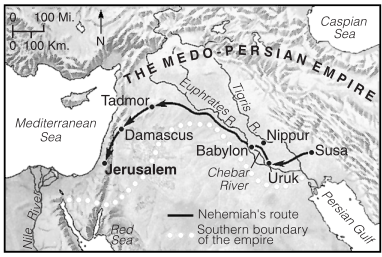Open Bible Data Home About News OET Key
A B C D E F G H I J K L M N O P Q R S T U V W XY Z
Tyndale Open Bible Dictionary
Intro ← Index → ©
NEHEMIAH (Person)
Name of three men mentioned in the OT after the period of the exile. The name means “the Lord comforts” and was appropriate for this time of hope and fulfillment.
1. Leader mentioned in a list of Jewish exiles who returned from Babylon with Zerubbabel sometime after 538 BC (Ezr 2:2; Neh 7:7).
2. Ruler of half the district of Beth-zur who helped rebuild the Jerusalem wall in 444 BC (Neh 3:16).
3. Governor of Judah during the restoration. Originally cupbearer to the Persian king Artaxerxes I (464–424 BC), Nehemiah pleaded to be sent to Judah to aid his fellow Jews in their difficulties and in particular to rebuild Jerusalem (Neh 1:1–2:8). He was appointed governor of Judah for 12 years.
After inspecting the walls upon his arrival, he realized that their repair was to be his prime task. This repair would guarantee the security of the city and could provide a focal point for the Jewish community scattered throughout Judah. That he was able to marshal support for this project and to complete it attests to his skills in management and administration. He also had a strong personal faith, as his prayers (Neh 1:4-11; 2:4) and conviction of divine guidance and help (2:8, 18, 20) attest. He had to overcome hostility and intimidation from powerful neighboring authorities in Samaria, Ammon, and Arabia (4:1-9; 6:1-14). He also required economic justice (ch 5). A few rich Jews were exploiting a food shortage by exacting high interest from their poorer brothers.
Included in Nehemiah’s concern for Jerusalem was a strong interest in the maintenance of temple worship. He was involved in the production of a document in which the Jewish community pledged themselves to support the temple personnel and to provide offerings (Neh 10:1, 32-39). Clearly, he realized that Judah needed at its heart a religious emphasis as well as political stability. These particular religious reforms are linked with those of his second period as governor (ch 13). Other reforms of that period concerned the observance of the Sabbath (13:15-22) and the problem of marriages to non-Jews (13:23-27). Nehemiah was a forceful leader (v 25) who used his imperial powers to restore to the settlers a national and religious identity in a period of political and economic weakness.
See also Nehemiah, Book of; Ezra (Person) #1; Ezra, Book of; Postexilic Period.

Nehemiah’s Journey to Jerusalem
When Nehemiah heard that the rebuilding projects in Jerusalem were progressing slowly, he asked the king of the Medo-Persian Empire, for whom he worked, for permission to go there to help his people complete the task of rebuilding their city’s walls. The king agreed to let him go; so he left as soon as possible, traveling along much the same route Ezra had taken seven years earlier.
